

MindMup: Zero-Friction Free Mind Mapping Software Online - Mind map in your browser. This operation requires a valid MindMup Gold License.

To export, save, publish and embed larger maps using MindMup Gold, please log in or sign up for a Gold account. Enter your e-mail or account name and we'll send you a one-time password. We have sent a temporary access code to your e-mail. Please wait, your license is being restored We could not find that email or username. If you are a new user select Sign up, or go Back to provide a different email.
Please wait, sending the access code to your e-mail. How to Design a Classroom Built on Inquiry, Openness and Trust. Teachers who are interested in shifting their classrooms often don’t know where to start.
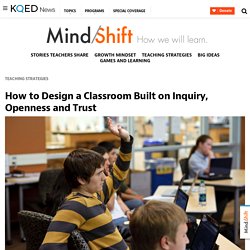
It can be overwhelming, frightening, and even discouraging, especially when no one else around you seems to think the system is broken. A question I’m asked often is, “Where should a teacher begin?” Should teachers just let students go or is there a process to good student-centered inquiry? I’ve reflected on this a fair amount, and I think small strategic steps are the key. Integrating the 16 Habits of Mind. In outcomes-based learning environments, we generally see three elements in play: 1) learning objectives or targets are created from given standards; 2) instruction of some kind is given; and then 3) learning results are assessed.
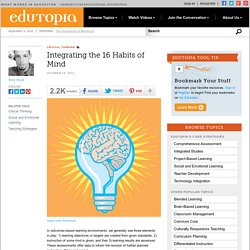
These assessments offer data to inform the revision of further planned instruction. Rinse and repeat. But lost in this clinical sequence are the Habits of Mind that (often predictably) lead to success or failure in the mastery of given standards. Resources Archive - James Dyson Foundation. Minds in Bloom: 72 Creative Ways for Students to Show What They Know. As we all know, students already get plenty of tests, so why not let your students show what they learned creatively?

Whether your students are reading independent books or your class has just finished a unit on space or pioneers, a culminating project can really cement that learning. Here are 72 fun and creative ways for your students to show what they know:Create a posterMake a PowerPoint PresentationDesign a modelMake a shoebox dioramaUse a three-panal display board Make a timelineCreate a board game incorporating key elements. 4 Phases of Inquiry-Based Learning: A Guide For Teachers. According to Indiana University Bloomington, Inquiry-based learning is an “instructional model that centers learning on a solving a particular problem or answering a central question.
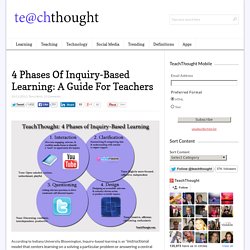
There are several different inquiry-based learning models, but most have several general elements in common: Learning focuses around a meaningful, ill-structured problem that demands consideration of diverse perspectivesAcademic content-learning occurs as a natural part of the process as students work towards finding solutionsLearners, working collaboratively, assume an active role in the learning processTeachers provide learners with learning supports and rich multiple media sources of information to assist students in successfully finding solutionsLearners share and defend solutions publicly in some manner” The process itself can be broken down into stages, or phases, that help teachers frame instruction.
Inquiry-Questions - home. Where the Wonders of Learning Never Cease. The Neuroscience Of Learning: 41 Terms Every Teacher Should Know - TeachThought. The Neuroscience Of Learning: 41 Terms Every Teacher Should Know by Judy Willis M.D., M.Ed., radteach.com As education continues to evolve, adding in new trends, technologies, standards, and 21st century thinking habits, there is one constant that doesn’t change.
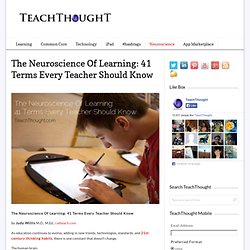
The human brain. But neuroscience isn’t exactly accessible to most educators, rarely published, and when it is, it’s often full of odd phrasing and intimidating jargon. Worse, there seems to be a disconnect between the dry science of neurology, and the need teachers have for relevant tools, resources, and strategies in the classroom. Brain Fitness Games.
Brain food for the thinking teacher. GoNoodle. Blooms20pyramid.jpg (JPEG Image, 1371 × 876 pixels) - Scaled (92. The thinking frames approach. CPD Introduction There are 5 key sections to the Thinking Frames Approach; Setting the Question, Brainwave, See, Think/Sequence, Paragraph.
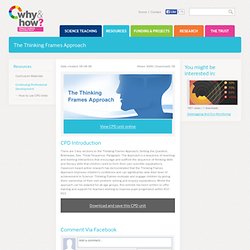
The Approach is a sequence of teaching and learning interactions that encourage and scaffold the sequence of thinking skills and literacy skills that children need to form their own scientific explanations. Classroom based action research has demonstrated that the Thinking Frames Approach improves children's confidence and can significantly raise their level of achievement in Science. Thinking Frames motivate and engage children by giving them ownership of their own problem solving and enquiry explanations. Whilst the approach can be adapted for all age groups, this website has been written to offer training and support for teachers wishing to improve pupil progression within KS2 - KS3. Welcome To Focus Education. John Langrehr Thinking Program. Scotland - Brainsmart. BRAINMAPS.ORG - BRAIN ATLAS, BRAIN MAPS, BRAIN STRUCTURE, NEUROINFORMATICS, BRAIN, STEREOTAXIC ATLAS, NEUROSCIENCE.
Sleep for Kids - Teaching Kids the Importance of Sleep. Educreations - Teach what you know. Learn what you don't. Teaching Students to Dig Deeper. Image credit: iStockphoto.

Procedures Place » Procedures. PLTS Wall Posters Draft Version 1. Have spent this morning compiling these draft A3 versions of student speak generic PLTS posters.

Wondering if anyone has any thoughts. Thanks in advance :0) Blogs, Articles and Videos from the World's Top Thinkers and Leaders. Homepage - ReadWriteThink. Minds in Bloom. Brainstorm and mind map online. Interactive Graphic Organizer. Holt Interactive Graphic Organizers "Graphic organizers are tools that help your brain think.
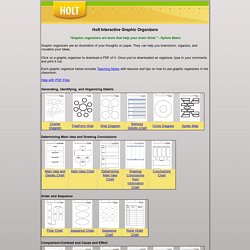
" - Kylene Beers Graphic organizers are an illustration of your thoughts on paper. They can help you brainstorm, organize, and visualize your ideas. Click on a graphic organizer to download a PDF of it. Once you’ve downloaded an organizer, type in your comments and print it out. Each graphic organizer below includes Teaching Notes with lessons and tips on how to use graphic organizers in the classroom. Help with PDF Files. Creately diagram software. Diagram software.
Exploratree - Exploratree by FutureLab. iPad Apps and Bloom’s Taxonomy I felt it was worthwhile to update the Top Post (over 25,000 views) on Langwitches: Bloom’s Taxonomy for iPads I have added links to each app represented on the visual. Remember: Exhibit memory of previously-learned materials by recalling facts, terms, basic concepts and answers. describenamefindnamelisttell Suggested apps: Apps to Support Bloom's Taxonomy - Android, Google, iPad and Web 2.0.
I had seen two great charts Kathy Schrock had made about Apps to Support Bloom's taxonomy. I have seen, and used, the ones for Android and Google. I just found two more on her site: iPad and Web 2.0 Apps. The charts are interactive and include links to apps organized by the category from Bloom: Creating, Evaluating, Analyzing, Applying, Understanding, and Remembering.
The apps I've checked out are all free. Some apps show up in more than one category too. The iPad and Android charts also have an activity listed under the apps, such as commenting, video creation, etc. Padagogy wheel download Carrington. Bloomin' Apps. This page gathers all of the Bloomin' Apps projects in one place.Each image has clickable hotspots and includes suggestions for iPad, Android, Google and online tools and applications to support each of the levels of Bloom's Revised Taxonomy.I have created a page to allow you to share your favorite online tool, iOS, or Android app with others. Cogs of the Cognitive Processes I began to think about the triangular shape of Bloom's Taxonomy and realized I thought of it a bit differently.Since the cognitive processes are meant to be used when necessary, and any learner goes in and out of the each level as they acquire new content and turn it into knowledge, I created a different type of image that showcased my thoughts about Bloom's more meaningfully.Here is my visual which showcases the interlocking nature of the cognitive processes or, simply, the "Cogs of the Cognitive Processes".
Bloom (Krathwohl and Anderson) and Web 2.0. Blooms taxonomy. Bloom’s Revised Taxonomy is indeed a good tool to structure, to organize and to reflect on lessons as well as to facilitate deeper understanding. After reading Bloom’s and ICT Tools I found a very nice guideline on Storybird: Bloom’s Taxonomy in the Classroom which is an overview of actions, questions and activities for teaching practices.
Plan 1: I share this with my colleagues and use this guideline for planning and reflecting my lessons more often. I would have never thought that there are so many more adjustments and adaptions of Bloom’s taxonomy. Several search keys in Google later I found Bloom’s Taxonomy for the iPads which interest me the most at the moment. Linking iPads & Bloom’s Taxonomy : Danny Maas, Emerging Technologies Consultant. Brain Nook. 6 ways to teach like an artist. Note from 11-8-2013: I wrote this post at the end of summer.
I've been developing the idea both in writing and by trying to live it out. After three months of that, I wrote a related article here: Five Benefits of Teaching Like an Artist “I am enough of an artist to draw freely upon my imagination. Kath Murdoch: Readings & Presentations. Thinking Classroom. iPhysEd - Inquiry & Technology in PE - Home. Authentic Inquiry Maths. Thinkers Keys - Classroom Ideas. Tony Ryan's Thinkers Keys Classroom Ideas:There are 20 different ‘Thinking Keys’ each designed to unlock different parts of the thinking process.The use of the keys helps to develop flexible problem solving and thinking habits.The thinking keys provide a flexible and dynamic way to engage students in further learning.
MA (Cantab), DPhil (Oxon), FBPsS, CPsychol. Thinkers Toolbox. Pak Heights Learner Rubric ALL.pdf. Resources. Questioning Toolkit. Essential Questions. THINKING MAPS. The Top 9 Mindmapping and Brainstorming Apps for iPad.